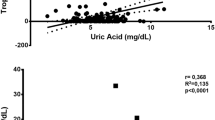Abstract
Objective
Percutaneous coronary intervention (PCI) triggers an acute inflammatory response, while sirolimus is known to have anti-inflammatory properties; the inflammatory system response to PCI after sirolimus-eluting stent placement remains unclear. The purpose of this study is to determine the changes in high sensitive C-reactive protein (hs-CRP) and apelin after PCI procedure and drug-eluting stent implantation in patients with and without reduced left ventricular systolic function.
Methods
Forty-eight consecutive patients undergoing PCI at the Beijing Anzhen Hospital between July and September 2006 were recruited. Sirolimus-eluting stents were employed in all patients. Blood samples were drawn immediately before and 24 h after the procedure. Plasma hs-CRP and apelin levels were determined by enzyme immunoassay.
Results
Paired t-test revealed a significant increase in both hs-CRP and apelin post-procedure (P=0.006 and P<0.0001, respectively). Patients with reduced left ventricular ejection fraction (LVEF) had significantly lower baseline apelin levels compared to those with normal ventricular function [(46.8±10.8) vs. (72.0±8.4) pg/ml, P<0.001]. However, apelin increased to a level similar to the level of those with normal left ventricular systolic function 24 h after the PCI procedure [(86.7±11.6) vs. (85.1±6.1) pg/ml, P=0.72].
Conclusions
hs-CRP and apelin levels increased after PCI and sirolimus-eluting stent implantation. Patients with impaired left ventricular systolic function had significantly lower baseline apelin levels, which increased significantly after PCI.
Similar content being viewed by others
References
Almagor, M., Keren, A., Banai, S., 2003. Increased C-reactive protein level after coronary stent implantation in patients with stable coronary artery disease. American Heart Journal, 145(2):248–253. [doi:10.1067/mhj.2003.16]
Bavry, A.A., Kumbhani, D.J., Helton, T.J., Borek, P.P., Mood, G.R., Bhatt, D.L., 2006. Late thrombosis of drug-eluting stents: a meta-analysis of randomized clinical trials. The American Journal of Medicine, 119(12):1056–1061. [doi: 10.1016/j.amjmed.2006.01.023]
Chen, M.M., Ashley, E.A., Deng, D.X., Tsalenko, A., Deng, A., Tabibiazar, R., Ben-Dor, A., Fenster, B., Yang, E., King, J.Y., et al., 2003. Novel role for the potent endogenous inotrope apelin in human cardiac dysfunction. Circulation, 108(12):1432–1439. [doi:10.1161/01.CIR.0000091235.94914.75]
Ellinor, P.T., Low, A.F., MacRae, C.A., 2006. Reduced apelin levels in lone atrial fibrillation. European Heart Journal, 27(2):222–226. [doi:10.1093/eurheartj/ehi648]
Gogo, P.B., Schneider, D.J., Watkins, M.W., Terrien, E.F., Sobel, B.E., Dauerman, H.L., 2005. Systemic inflammation after drug-eluting stent placement. Journal of Thrombosis and Thrombolysis, 19(2):87–92. [doi:10.1007/s11239-005-1378-6]
Habata, Y., Fujii, R., Hosoya, M., Fukusumi, S., Kawamata, Y., Hinuma, S., Kitada, C., Nishizawa, N., Murosaki, S., Kurokawa, T., et al., 1999. Apelin, the natural ligand of the orphan receptor APJ, is abundantly secreted in the colostrum. Biochimica et Biophysica Acta, 1452(1):25–35. [doi:10.1016/S0167-4889(99)00114-7]
Hofma, S.H., van der Giessen, W.J., van Dalen, B.M., Lemos, P.A., McFadden, E.P., Sianos, G., Ligthart, J.M., van Essen, D., de Feyter, P.J., Serruys, P.W., 2006. Indication of long-term endothelial dysfunction after sirolimuseluting stent implantation. European Heart Journal, 27(2):166–170. [doi:10.1093/eurheartj/ehi571]
Hosoya, M., Kawamata, Y., Fukusumi, S., Fujii, R., Habata, Y., Hinuma, S., Kitada, C., Honda, S., Kurokawa, T., Onda, H., et al., 2000. Molecular and functional characteristics of APJ. Tissue distribution of mRNA and interaction with the endogenous ligand apelin. Journal of Biological Chemistry, 275(28):21061–21067. [doi:10.1074/jbc.M908417199]
Katugampola, S.D., Maguire, J.J., Matthewson, S.R., Davenport, A.P., 2001. [(125)I]-(Pyr(1)) apelin-13 is a novel radioligand for localizing the APJ orphan receptor in human and rat tissues with evidence for a vasoconstrictor role in man. British Journal of Pharmacology, 132(6): 1255–1260. [doi:10.1038/sj.bjp.0703939]
Kim, J.Y., Ko, Y.G., Shim, C.Y., Park, S., Hwang, K.C., Choi, D., Jang, Y., Hung, N., Shim, W.H., Cho, S.Y., 2005. Comparison of effects of drug-eluting stents versus bare metal stents on plasma C-reactive protein levels. The American Journal of Cardiology, 96(10):1384–1388. [doi:10.1016/j.amjcard.2005.07.042]
Kleinz, M.J., Davenport, A.P., 2004. Immunocytochemical localization of the endogenous vasoactive peptide apelin to human vascular and endocardial endothelial cells. Regulatory Peptides, 118(3):119–125. [doi:10.1016/j.regpep.2003.11.002]
Kochiadakis, G.E., Marketou, M.E., Arfanakis, D.A., Sfiridaki, K., Skalidis, E.I., Igoumenidis, N.E., Hamilos, M.I., Kolyvaki, S., Chlouverakis, G., Kantidaki, E., et al., 2007. Reduced systemic inflammatory response to implantation of sirolimus-eluting stents in patients with stable coronary artery disease. Atherosclerosis, 194(2):433–438. [doi:10.1016/j.atherosclerosis.2006.08.029]
Kornowski, R., Hong, M.K., Tio, F.O., Bramwell, O., Wu, H., Leon, M.B., 1998. In-stent restenosis: contributions of inflammatory responses and arterial injury to neointimal hyperplasia. Journal of the American College of Cardiology, 31(1):224–230. [doi:10.1016/S0735-1097(97)00450-6]
Masri, B., Morin, N., Cornu, M., Knibiehler, B., Audigier, Y., 2004. Apelin (65–77) activates p70 S6 kinase and is mitogenic for umbilical endothelial cells. The FASEB Journal, 8(5):1909–1911. [doi:10.1096/fj.04-1930fje]
Oberhoff, M., Herdeg, C., Baumbach, A., Karsch, K.R., 2002. Stent-based antirestenotic coatings (sirolimus/paclitaxel). Catheterization and Cardiovascular Interventions, 55(3): 404–408. [doi:10.1002/ccd.10034]
Serry, R., Penny, W.F., 2005. Endothelial dysfunction after sirolimus-eluting stent placement. Journal of the American College of Cardiology, 46(2):237–238. [doi:10.1016/j.jacc.2005.04.020]
Szokodi, I., Tavi, P., Foldes, G., Voutilainen-Myllyla, S., Ilves, M., Tokola, H., Piuhola, J., Rysä, J., Tóth, M., Ruskoaho, H., 2002. Apelin, the novel endogenous ligand of the orphan receptor APJ, regulates cardiac contractility. Circulation Research, 91(5):434–440. [doi:10.1161/01.RES.0000033522.37861.69]
Tatemoto, K., Hosoya, M., Habata, Y., Fujii, R., Kakegawa, T., Zou, M.X., Kawamata, Y., Fukusumi, S., Hinuma, S., Kitada, C., et al., 1998. Isolation and characterization of a novel endogenous peptide ligand for the human APJ receptor. Biochemical and Biophysical Research Communications, 251(2):471–476. [doi:10.1006/bbrc.1998.9489]
Togni, M., Windecker, S., Cocchia, R., Wenaweser, P., Cook, S., Billinger, M., Meier, B., Hess, O.M., 2005. Sirolimuseluting stents associated with paradoxic coronary vasoconstriction. Journal of the American College of Cardiology, 46(2):231–236. [doi:10.1016/j.jacc.2005.01.062]
Author information
Authors and Affiliations
Corresponding author
Additional information
Project (No. QN2008-001) supported by the Beijing Municipal Health Bureau Young Persons’ Foundation, China
Rights and permissions
About this article
Cite this article
Du, X., Kang, Jp., Wu, Jh. et al. Elevated high sensitive C-reactive protein and apelin levels after percutaneous coronary intervention and drug-eluting stent implantation. J. Zhejiang Univ. Sci. B 11, 548–552 (2010). https://doi.org/10.1631/jzus.B1001004
Received:
Accepted:
Published:
Issue Date:
DOI: https://doi.org/10.1631/jzus.B1001004




